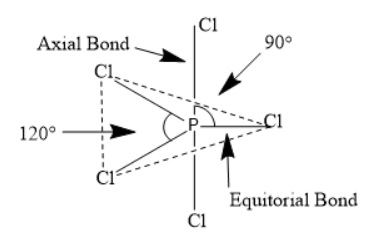
Explain hybridization of central atom in \[PC{l_5}\]
Answer
556.5k+ views
Hint:
We need to find hybridization of a given molecule. We can find the hybridization by knowing the number of sigma bonds and lone pairs present on the central atom.
Complete step by step answer:
Hybridization is the concept of mixing atomic orbitals into new hybrid orbitals with different energies, shapes etc, that are suitable for the pairing of electrons to form chemical bonds in valence bond theory.
${\rm{z}} = \;{\rm{no}}{\rm{.}}\;{\rm{of}}\;\sigma \;{\rm{bond}}\; + \;{\rm{l}}{\rm{.p}}\;{\rm{on}}\;{\rm{central}}\;{\rm{atom}}$
Where, No. of $\sigma $bond means single bond and l.p is the lone pair present on the central atom.
The phosphorus has atomic number $15$ and valence electrons that are present are $5$. These five electrons present, will make bonds with five $Cl$ that are there in \[PC{l_5}\].There is no lone pair present.
The Hybridisation of \[PC{l_5}\] will be $S{p^3}d$ as z is equal to five and corresponding geometry will be trigonal bipyramidal. There will be two types of bonds that will be formed in \[PC{l_5}\] that are equatorial bonds and axial bonds.

The structure which we can see has trigonal bipyramidal geometry and three chlorine atoms are present at the corner of a triangle whereas two chlorine atoms present are at axial position.
Equatorial bonds: There will be three $P - Cl$ equatorial bonds which will lie in a single plane to make an angle with each other. The angle between the $P - Cl$ bond will be $120^\circ $.
Axial bonds: There will be two $P - Cl$ axial bonds where one bond will lie above the equatorial plane and other will lie below the plane.. The angle between the $P - Cl$ bond will be $90^\circ $.
Note:The axial bonds will always be longer than the equatorial bonds as axial bonds are nearer to equatorial bonds so it experiences greater repulsion from equatorial bonds. As phosphorus is -$S{p^3}d$ hybridization and it forms five equivalent $S{p^3}d$ orbitals which each contain an unpaired electron and results in the formation of trigonal bipyramidal geometry.
We need to find hybridization of a given molecule. We can find the hybridization by knowing the number of sigma bonds and lone pairs present on the central atom.
Complete step by step answer:
Hybridization is the concept of mixing atomic orbitals into new hybrid orbitals with different energies, shapes etc, that are suitable for the pairing of electrons to form chemical bonds in valence bond theory.
${\rm{z}} = \;{\rm{no}}{\rm{.}}\;{\rm{of}}\;\sigma \;{\rm{bond}}\; + \;{\rm{l}}{\rm{.p}}\;{\rm{on}}\;{\rm{central}}\;{\rm{atom}}$
Where, No. of $\sigma $bond means single bond and l.p is the lone pair present on the central atom.
| Z | Hybridisation |
| $2$ | $Sp$ |
| $3$ | $S{p^2}$ |
| $4$ | $S{p^3}$ |
| $5$ | $S{p^3}d$ |
The phosphorus has atomic number $15$ and valence electrons that are present are $5$. These five electrons present, will make bonds with five $Cl$ that are there in \[PC{l_5}\].There is no lone pair present.
The Hybridisation of \[PC{l_5}\] will be $S{p^3}d$ as z is equal to five and corresponding geometry will be trigonal bipyramidal. There will be two types of bonds that will be formed in \[PC{l_5}\] that are equatorial bonds and axial bonds.

The structure which we can see has trigonal bipyramidal geometry and three chlorine atoms are present at the corner of a triangle whereas two chlorine atoms present are at axial position.
Equatorial bonds: There will be three $P - Cl$ equatorial bonds which will lie in a single plane to make an angle with each other. The angle between the $P - Cl$ bond will be $120^\circ $.
Axial bonds: There will be two $P - Cl$ axial bonds where one bond will lie above the equatorial plane and other will lie below the plane.. The angle between the $P - Cl$ bond will be $90^\circ $.
Note:The axial bonds will always be longer than the equatorial bonds as axial bonds are nearer to equatorial bonds so it experiences greater repulsion from equatorial bonds. As phosphorus is -$S{p^3}d$ hybridization and it forms five equivalent $S{p^3}d$ orbitals which each contain an unpaired electron and results in the formation of trigonal bipyramidal geometry.
Recently Updated Pages
Master Class 12 English: Engaging Questions & Answers for Success

Master Class 12 Economics: Engaging Questions & Answers for Success

Master Class 12 Social Science: Engaging Questions & Answers for Success

Master Class 12 Maths: Engaging Questions & Answers for Success

Master Class 12 Chemistry: Engaging Questions & Answers for Success

Master Class 12 Business Studies: Engaging Questions & Answers for Success

Trending doubts
What are the major means of transport Explain each class 12 social science CBSE

Which are the Top 10 Largest Countries of the World?

Draw a labelled sketch of the human eye class 12 physics CBSE

Explain sex determination in humans with line diag class 12 biology CBSE

The pH of the pancreatic juice is A 64 B 86 C 120 D class 12 biology CBSE

Explain sex determination in humans with the help of class 12 biology CBSE




